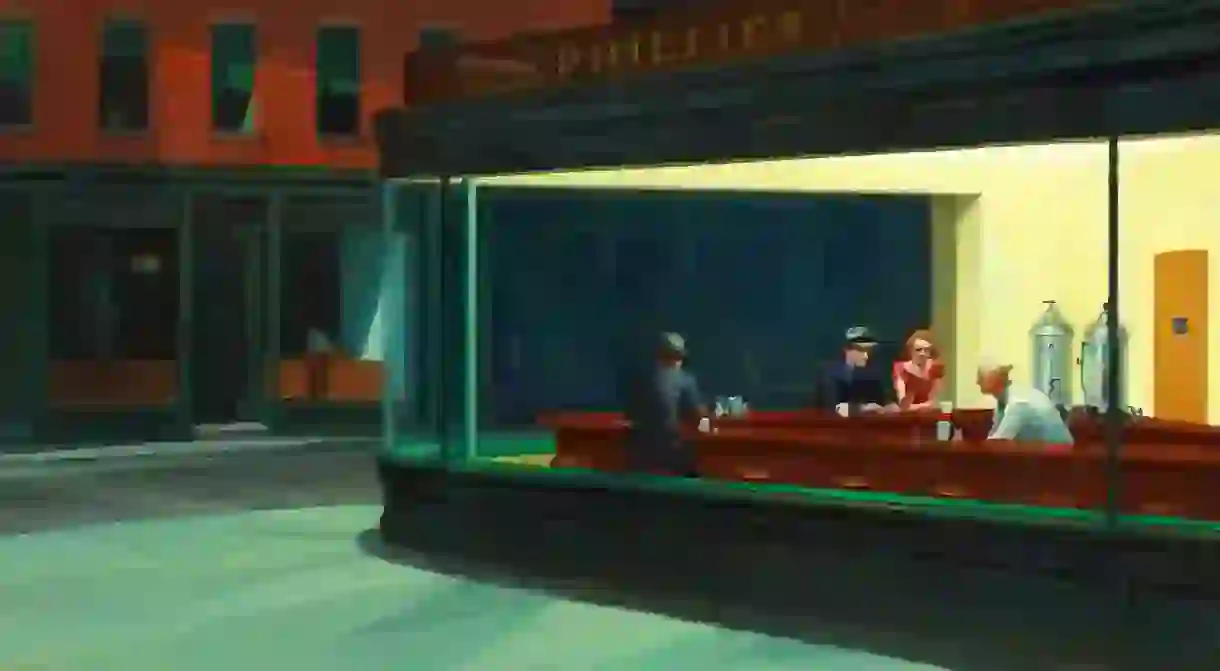How New York Shaped Artist Edward Hopper

Edward Hopper spent his whole life in New York, moving to New York City from Nyack when he was around 30 years old. New York undeniably shaped him and his career, from his early sketches of the Hudson River to the invaluable support he received from Gertrude Vanderbilt Whitney.
Known for his realist oil paintings depicting solitary scenes, Edward Hopper was an artist whose aesthetic is instantly recognizable. His lonesome interiors, from a Manhattan diner to a room in Brooklyn, were reflections of his native New York, a state he left sparingly (he traveled to Cape Cod for about 40 of his 84 summers). The city offered him inspiration and opportunities, ultimately leading to a successful career that will be on display in a major retrospective at the Whitney Museum of American Art in 2021. From above-ground daily commutes on the city’s old elevated trains to a burgeoning culture of diners, New York City’s dynamism and effect on Hopper’s daily life shines in his work.

The artist Edward Hopper was born in Nyack, New York, in 1882. The home in which he grew up, one block up from the Hudson River, is now the Edward Hopper House Museum & Study Center, which displays his early works and hosts artists inspired by or who were contemporaries of the artist.

“[W]hen he was a little boy, [Hopper] was very, very influenced by the Hudson River in particular,” Jennifer Patton, the executive director of the Edward Hopper House, says. “ [His house] looks right over the Hudson River. It’s on Broadway, which is parallel to the river, and his whole house is saturated by the light that comes through the river.”
Hopper’s art often features streams of light that mirror the beams shining into his childhood home in Nyack. The light, the river and the architecture of his youth are present in his oeuvre.

Patton points to paintings such as Early Sunday Morning and House by the Railroad and an early watercolor titled Hook Mountain, depicting the first mountain that leads toward Bear Mountain State Park on the Hudson River, as examples of local buildings and natural landmarks that appear in Hopper’s works.
Hopper could often be found on or beneath the hill, etching the river and mountains. The natural wonders of his early work give rise to his appreciation of a building’s architecture once he moved to the city. But growing up in Nyack left an impression on his aesthetic. In 1913, Hopper moved to Manhattan’s Greenwich Village, where he remained for the rest of his life. It was there that his career took off.

“Nyack is essential to the formation of the artist,” Patton says, “and New York City is essential to the mature works of the artist.”
In the Village, the heiress and artist Gertrude Vanderbilt Whitney had a studio to which she invited artists to come and create with her.
“She provided a tremendous amount of support and network for the artists that she asked to come draw and paint in her studio, and Hopper was one of them,” Patton says. “When Gertrude Vanderbilt Whitney had eventually collected an enormous collection because of all these artists donating works of art to her, she went to the Metropolitan Museum of Art and she said, ‘Would you like my collection of contemporary American art? I’ll give it to you.’ And they said ‘No, we don’t want this collection.’ And so she started the Whitney Museum.”
Throughout Hopper’s career, he had a deep connection to the Whitney, a relationship that proved to be fruitful for artist and institution alike. In 1920, Hopper’s first solo show was hosted by the Whitney Studio Club, an inchoate version of what would eventually become the museum. He showed 16 paintings but none sold. In 1922, his second solo show was again at the Whitney Studio Club. Over the years, he participated in nearly every Whitney biennial and annual, and the museum hosted two major retrospectives of his career, one in 1950 and another in 1964, three years before his death. When his wife, artist Jo Hopper, died in 1968, she bequeathed his estate of nearly 3,000 works to the Whitney.
New York changed drastically over Hopper’s lifetime, and his work captures some of these shifts. For instance, prior to the 1930s, restaurants in the city were traditionally in hotel lobbies with white tablecloths, but as life sped up, along came the automats and diners. Paintings such as Automat and Nighthawks immortalize these newcomers of the service scene in dark blacks and greens.
The now-defunct elevated trains in Manhattan were pivotal for Hopper’s sensibility. From this vantage point, the artist had a clear look into the windows of the residents of the city. As a result, Hopper’s work is imbued with a voyeuristic feeling of a freeze-framed glimpse into someone else’s world, a homed-in look at the ennui experienced in our private spaces that can become public, if only for a fleeting moment.
And of course, New York was brimming with culture at this time, from the Harlem Renaissance artists to the Abstract Expressionists. And Hopper absorbed these influences through his interest in the arts.
“All the theaters of the Village, all the culture, he soaked it all up,” Patton says. “He went to every film. He went to every performance. He was constantly inspired by the performing arts and film arts and visual arts and musical arts, so obviously that wouldn’t have happened to the extent that it did if he didn’t live in New York City.”













